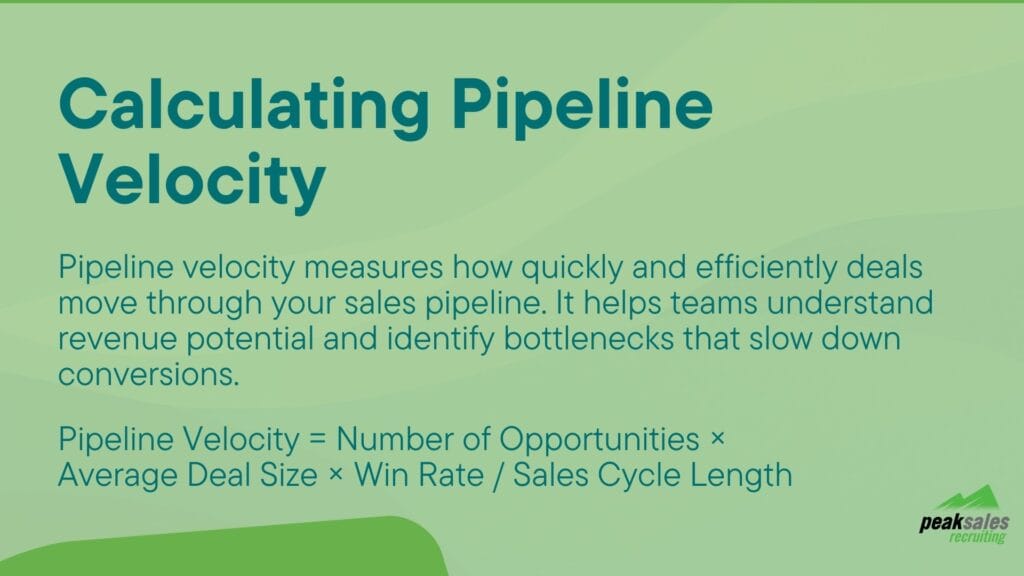Pipeline velocity is a crucial concept for sales teams striving to maximize efficiency and revenue. Understanding how quickly opportunities progress through the sales pipeline can help businesses understand potential bottlenecks, optimize sales strategies, and make more informed decisions.
Whether you’re running a small business or managing a large sales organization, mastering pipeline velocity can significantly improve sales performance and overall effectiveness.
What Is Pipeline Velocity?
Pipeline velocity is a sales metric that quantifies how quickly opportunities move through your sales pipeline. It measures the efficiency of your sales process by calculating the revenue potential of your pipeline over a given time frame. This metric provides a snapshot of your sales team’s ability to close deals and generate revenue.
To calculate pipeline velocity, use the following formula:
Pipeline Velocity = Number of Opportunities × Average Deal Size × Win Rate / Sales Cycle Length

This formula incorporates key metrics such as the number of qualified opportunities, average deal size, and win rate while accounting for the average time it takes to close deals. However, pipeline velocity is not just about the numbers; it’s a framework for identifying bottlenecks, assessing sales performance, and making data-driven business decisions.
Why Is Pipeline Velocity Important?
Understanding and optimizing pipeline velocity can:
- Boost Revenue Predictions: A clear view of pipeline velocity helps in making accurate revenue forecasts.
- Enhance Sales Efficiency: Identifying slow-moving stages in the pipeline enables teams to refine their strategies.
- Align Sales and Marketing Efforts: Monitoring velocity ensures both teams work in sync to optimize lead generation, conversion, and overall effectiveness.
- Reduce Customer Acquisition Costs (CAC): A faster-moving pipeline lowers the resources spent per deal.
- Improve Sales Strategies: By analyzing pipeline metrics, sales organizations can craft tailored approaches to meet sales goals.
- Support Sales Forecasting: Accurate pipeline velocity data supports better sales forecasting and business decisions.
Pipeline velocity measures provide actionable insights into your sales funnel velocity and allow for data-driven improvements in sales and marketing efforts.
Pipeline Velocity Formulas: Are They Helpful?
While the formula provides valuable insights, it’s essential to view it as a diagnostic tool rather than a one-size-fits-all solution. Here’s how to think about measuring pipeline velocity:
- Context Matters: The formula works best when tailored to your industry and business model. For example, a B2B enterprise with long sales cycles will interpret velocity differently from an e-commerce startup.
- Combine Quantitative and Qualitative Data: Numbers alone don’t tell the full story. Supplement metrics with qualitative insights from your sales team and sales reps.
- Monitor Trends Over Time: A single snapshot of pipeline velocity is less valuable than tracking it consistently to identify patterns.
- Consider Sales KPIs: Include metrics like win rate, conversion rate, and sales cycle duration to evaluate your pipeline.
- Evaluate Inventory Velocity: For product-based businesses, inventory velocity can play a critical role in understanding overall sales velocity.
By leveraging accurate data and evaluating sales velocity equations critically, businesses can uncover potential roadblocks in the customer journey and tailor their sales strategies accordingly.
10 Ways to Improve Pipeline Velocity
- Shorten Sales Cycles: Use automation tools, such as CRM systems and sales enablement tools, to reduce administrative tasks and move deals through the pipeline quicker.
- Improve Lead Qualification: Focus on generating and prioritizing sales-qualified leads by refining your ideal customer profile and addressing customer’s pain points.
- Enhance Sales Training: Equip your team with skills to close deals faster by understanding specific needs and potential roadblocks of potential buyers.
- Leverage Data Analytics: Use analytics tools to identify bottlenecks, evaluate conversion rates, and optimize sales performance.
- Streamline Communication: Ensure smooth collaboration between sales and marketing teams to eliminate delays in the marketing funnel and sales funnel velocity.
- Adopt Account-Based Marketing Strategies: Tailor your approach to high-value prospects for greater sales success.
- Optimize Onboarding and Demos: Create an effective onboarding process and product demo experience for customers, reducing the time spent in the evaluation stage.
- Set Realistic Sales Quotas: Ensure that sales quotas are achievable and aligned with your company’s ability to support high-performing sales reps.
- Experiment with Pricing Models: Test different pricing strategies to determine what aligns best with your target audience’s needs and leads to quicker conversion.
- Focus on the Early Stages: Addressing the early stages of the sales funnel can lead to more qualified opportunities and higher conversion rates.
Implementing these strategies leads to high sales velocity, improved customer relationship management, and an increase in Monthly Recurring Revenue (MRR) or Annual Contract Value (ACV).

Expectations for Different Industries, Deal Sizes, and More
Pipeline velocity varies significantly across industries, deal sizes, and market segments. Here’s what to consider:
- Industry: SaaS companies typically have shorter sales cycles and quicker time-to-close compared to manufacturing businesses, which often deal with longer timeframes and more complex processes.
- Deal Size: Larger deals, such as those with high Annual Contract Value, generally have lower velocity due to extended negotiation and approval processes. However, the total value of these deals often compensates for the lower velocity.
- Customer Segments: Enterprise clients may take more time to close than SMBs, but their higher Average Revenue and customer lifetime value can justify the additional effort.
- Market Conditions: Adapt your strategies to current market conditions and anticipate changes that could impact sales velocity.
- Small Businesses: These often benefit from shorter cycles and quicker decision-making, making high velocity more achievable.
By aligning expectations with specific timeframes and industry norms, companies can create realistic benchmarks for sales success.
The Bottom Line
Pipeline velocity is not just a metric; it’s a crucial lens for evaluating and optimizing your sales process. Understanding its significance and customizing its measurement to fit your context can help accelerate your sales pipeline and drive sustainable growth. Tracking pipeline velocity alongside key metrics like Click-Through Rate, Closing Ratio, and cash flow enables businesses to make informed decisions and refine their sales strategies. Sales leaders should regularly assess pipeline metrics, focusing on qualified and closed-won opportunities and sales goal achievement.
Utilizing CRM systems and sales data enhances sales forecasting and increases conversion rates, ultimately leading to improved sales performance and success.
For more sales content, check out The Peak Blog.



